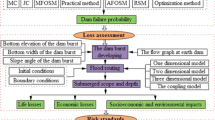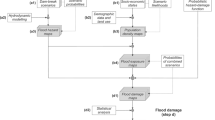Abstract
In the risk analysis for dam safety assessment, the economic damages due to flooding resulting from a dam failure should be estimated precisely to quantify the potential risks of the dam as the dollar damage and calculate the cost effectiveness of various dam risk reduction measures proposed to improve safety of the dam. However, the common approach of estimating economic damages with the relationship between flood depths and percent damage values at the damage centers are subject to uncertainty, because some degrees of uncertainties are involved in the flood depths predicted by the dam breach flood routing analysis models and defined percent damage values in the relationships. This paper identified the degrees of uncertainties in the predicted economic damages by considering both the amount of the uncertainty in the predicted flood depths and the percent damage values in process of the economic damage estimation. The amount of uncertainty in the estimated flood depths were obtained from the uncertainty analysis on the dam breach flood routing analysis results using a computational model, while the possible variation ranges of the percent damage values were assumed based on the recommend values. The main purpose of this study is to contribute to define the uncertainty in the estimated risks of an existing dam. However, the approaches introduced by this study may be utilized to identify the amount of uncertainty in the other types flood damages due to a dam failure.
Similar content being viewed by others
Reference
Bohn, M.P., Whleer, T.A., and Parry, G.W. (1988)Approaches to uncertainty analysis in probabilistic risk assessment, NUREG/CR-4836, SAND 87-0871, U.S.A.
Bowles, D.S. (2000) “Advances in the practice and use of portfolio risk assessment.”Proceedings of the 2000 Australian Committee on Large Dams (ANCOLD) Annual Meeting, Cairns, Queensland, Australia.
Charles Yoe (1992) “Quantitative risk assessment and technology transfer: Software developments.”Risk-based decision making in water resources V, ASCE. pp. 92–107.
Federal Energy Regulatory Commission (1991)Engineering guidelines for evaluation of hydropower projects, Office of Hydropower Licensing, Washington, D.C., U.S.A.
Fread, D.L. (1981) “Some limitations of dam break flood routing models,”ASCE Fall Convention, St. Louis, MO, U.S.A., p. 15.
Fread, D.L. (1984)DAMBRK: The NWS Dam-Break Flood Forecasting Model, National Weather Service (NWS), Maryland, U.S.A.
Froehlich, D.C. (1995), “Embankment dam breach parameters revisited.”ASCE Conference on Water Resources Engineering, San Antonio, TX, U.S.A.
Jarrett, R.D. (1984), “Hydraulics of high gradient streams,”J. of hydraulic engineering, ASCE, Vol. 10, No. 11, pp. 1519–1539.
Lee J.S. (2002) “Uncertainty in dam breach flood routing results for dam safety risk assessment.”Korea water engineering research, Vol. 3, No. 4, pp. 215–234.
Karl, M.D. (1998). “Risk analysis of a seepage/piping dam safety issue.”Managing the risks of dam project development, safety and operation: Eighteenth annual USCOLD lecture series, Buffalo, NY, U.S.A.
Kung C.S. and Yang X.L. (1993)Dam-break flood simulation and river parameter uncertainty, Royal Institute of technology, Stockholm, Sweden.
Morgan, M.G. and Henrion, M. (1990)Uncertainty: A guide to dealing with uncertainty in quantitative risk and policy analysis, Cambridge university press, NY, U.S.A.
Moore, D.S. and McCabe, G.P. (1993)Introduction to the practice of statistics, W.H. Freeman and Company, NY, U.S.A.
National Weather Service (1998)National Weather Service FLDWAV MODEL, Version 1.0, Hydrologic research laboratory, Office of hydrology, National Weather Service (NWS), NOAA.
Palisade Corporation (1996)Guide to using @Risk. Risk analysis and simulation add-in for Microsoft Excell or Lotus 1-2-3, Newfield, NY, U.S.A.
RAC Engineers & Economists and U.S. Army Corps of Engineers (1999)Alamo Dam Demonstration Risk Assessment: Summary Report (Draft report), Los Angeles District, LA, U.S.A.
U.S. Army Corps of Engineers (1986)General report flood emergency plan for Alamo Dam, Los Angeles District, LA, U.S.A.
U.S. Army Corps of Engineers (1992)Guidelines for risk and uncertainty analysis in water resources planning, Volume II. IWR Report92-R-2, U.S.A.
Vick, S. and Stewart, R. (1996) “Risk analysis in dam safety practice, Uncertainty in the geologic environment: From theory to practice.”Geotechnical Special Publication, ASCE, No. 58, pp. 586–603.
Von Thun, Lawrence, J., and Gillette, D.R. (1990) “Guidance on breach parameters.” Unpublished manuscript, p. 15.
Wahl, T.L. (1998) Predictionof embankment dam breach parameters: A literature review and needs assessment, DSO-98-004, U.S. Bureau of Reclamation, U.S.A..
Author information
Authors and Affiliations
Additional information
The manuscript for this paper was submitted for review on September 17, 2002.
Rights and permissions
About this article
Cite this article
Lee, JS., Noh, J.W. The impacts of uncertainty in the predicted dam breach floods on economic damage estimation. KSCE J Civ Eng 7, 343–350 (2003). https://doi.org/10.1007/BF02831783
Issue Date:
DOI: https://doi.org/10.1007/BF02831783




